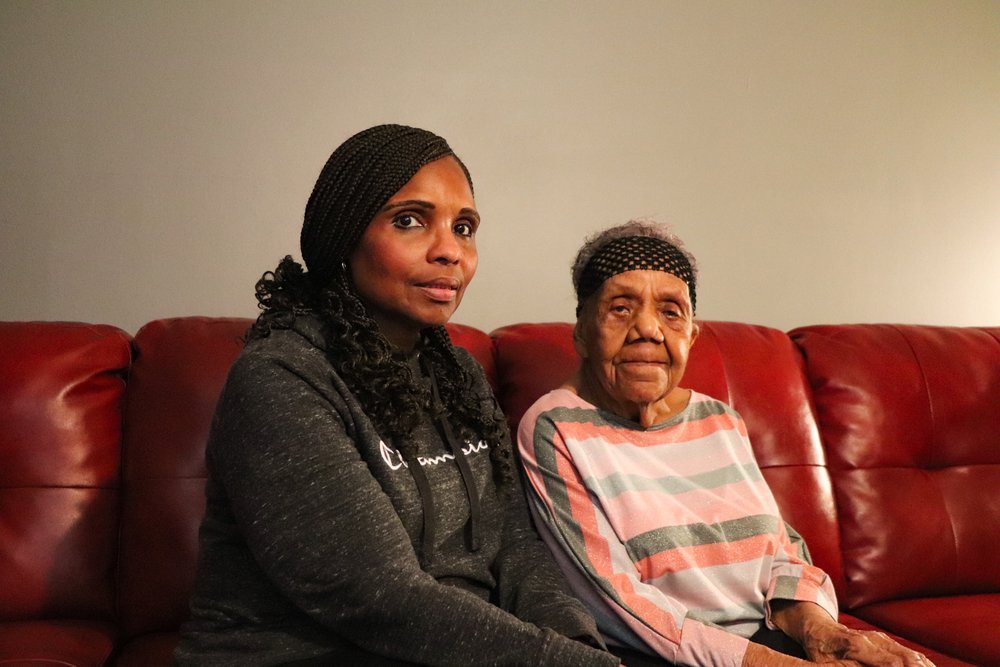This story was originally published by City Bureau. Printed with permission.
Marion Turner moved to Wicker Park in the 1950s, when vacant buildings and crime were common and the city’s disinvestment in the neighborhood was painfully apparent.
In the 1970s, Turner started looking for a new apartment after police called her one night asking and informing her about a man who had been killed outside of her unit. She later heard from a friend about the Pierce North Apartments, just down the street. When she first laid eyes on the building, the state of the property was less than ideal. But Turner was determined to be in a new apartment building. Cockroaches scurried across the floor, and after she set off a dozen bug bombs she moved in. Turner settled in in the building, which in 1982 became the Woolman-Washington housing cooperative with Turner as a co-founder.
“I feel good, I feel safe,” said Turner, ninety-three, who still lives there today and has seen the building go through multiple rehabs and renovations. She sat in her apartment, gray hair swept up on her head, beside her fellow co-op member and granddaughter, Kimberly Turner. The elder woman has trouble hearing, so her granddaughter helped her through the interview.
Co-op members at Woolman-Washington don’t pay rent to a landlord; instead, they are partial owners of the property. Kimberly Turner is the board’s current president, and all members make collective decisions on maintenance requests, approving new applicants, and more.
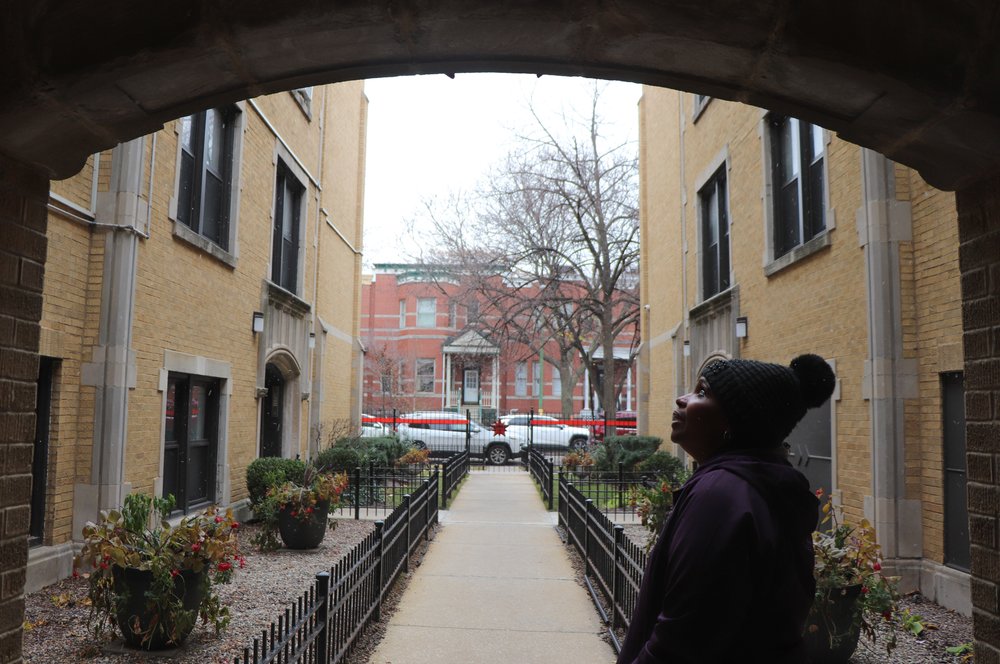
As the neighborhood gentrified, new buildings emerged and housing costs increased. Woolman-Washington, however, offers limited-equity units, meaning that co-op members are limited in how much they can profit from the cooperative. This model decreases the likelihood of displacement by keeping properties affordable for community members who otherwise may be priced out.
If a shareholder sells their share (their unit), they are allowed to remake the amount they initially put in, but they can’t charge more than they paid—and they can’t sell to, say, developers who might increase the prices of the unit.
Inflation, increased housing demand, rising property taxes, and a recent pullback on pandemic-related rental support have exacerbated the city’s affordable housing crisis. The Tribune reports that average rent in the city has increased around nine percent since 2021. As the cost of living steadily rises, so does the need for affordable housing options, especially on Chicago’s South and West Sides where the city is increasing investment in economic development.
The City recently launched two pilot programs intended to support limited-equity cooperatives. Though some housing co-ops have struggled, City Bureau spoke with co-op members, city officials, and organizers over the course of eleven weeks about whether limited-equity housing co-ops have the potential to provide affordable housing for low- to middle-income residents.
History of housing co-ops
Chicago’s first housing cooperatives were built along the northern and southern shores in the 1920s after World War I, as the nation endured housing shortages and increased rent prices. Many upper-middle-class white residents owned these co-ops because they wanted to enjoy home ownership at a cheaper price and “handpick” their neighbors, as a 1927 Tribune article stated.
The Great Depression bankrupted over seventy-five percent of Chicago’s co-ops, according to The Encyclopedia of Chicago. After World War II, housing shortages combined with new policies — like Federal Housing Administration insurance of blanket mortgages on cooperatives and new types of subsidies — helped spark a new era of housing co-ops. Co-ops sprung up across the city: senior co-ops, luxury co-ops, middle-income co-ops and limited housing equity co-ops.
While white co-ops often excluded Black Chicagoans, Black residents saw the cooperative model as a more accessible pathway to home ownership. In 1960, the Chicago Defender published an article calling co-ops the best opportunity for Black residents to become homeowners. The story mentioned the growing number of interracial co-ops in Chicago, specifically the Pioneer Cooperative on Dorchester in Hyde Park-Kenwood.
South Shore native Deborah Harrington returned to Chicago in the 1970s after working as a government researcher in Washington, D.C. She was in her twenties and wasn’t interested in moving back into her parents’ home. She wanted to own property.
Buying her own house was too expensive, and her mother, a local block club organizer, suggested that she look into housing cooperatives as an alternative. A friend who lived in a co-op in South Shore invited Harrington to check it out in person. Harrington remembers being drawn to the “splendor” of the environment, especially the lakefront views and the ornate architectural details of the building. Although the co-op was majority white, she could envision herself living there as a Black woman. When a vacancy opened, Harrington said she jumped at the opportunity.
Harrington, who had an interest in real estate (and would later go on to get her real estate license), said she drafted a lease agreement and paid for the unit in cash. While she had the funds and the qualifications to become a shareholder in the co-op, Harrington said the board denied her request to join. “It rocked my world,” said Harrington. “I really didn’t expect that.”
By that time, South Shore had become a majority Black community, but the neighborhood’s most historic co-ops still reflected the mostly white makeup of its original shareholders from sixty years prior. Harrington said the all-white board wasn’t interested in changing that.
She resolved to join the co-op whether they wanted her or not. Harrington said she sued the co-op for discrimination, won, and moved in.
A few years later, Harrington said she earned a spot on the co-op’s board, and she remained a co-op member for another decade before moving nearby to The Coastland, another historic lakefront co-op, which she has called home for the past thirty-one years.
Harrington has lived solely in market rate co-ops, which allow her to sell her unit at the highest price someone is willing to pay. Harrington said she admires how involved co-op members are within their own properties and surrounding communities. She also recognizes that making collective decisions can be challenging.
“It does give one a sense of agency because you’re not like a condominium with your unit and your deed,” Harrington said. “You’re forced, so to speak, to govern collectively.”
Linda Greene worked for the Neighborhood Institute, a South Shore nonprofit in the 1980s. Greene was part of the group that helped create what is now the limited-equity Genesis Cooperative Housing.
Though she did not join Genesis herself, Greene said her involvement with the project led her to apply for a unit at the Rocky Ledge co-op, a market rate housing cooperative in South Shore. She’s lived there ever since. Although more expensive than a limited-equity co-op, Greene said Rocky Ledge was more affordable than other housing options.
She was also organizing around housing cooperatives in the late 1980s when the city was losing interest in supporting them after some failed and had to shift their ownership structure.
“It got to the point that the City, the State, nobody wanted to fund any new housing cooperatives,” Greene said. She added, “Well a lot of rental projects don’t do well either … [The City is] not saying ‘I’m never doing those again,’ but as soon as a co-op fails, [they] can’t do that anymore.”
In the early 2000s, some established cooperatives continued to operate successfully while new ones sprouted up across Chicago. Despite the mounting evidence that housing co-ops could be a sustainable and affordable housing model, co-op advocates said the City has not supported them at the levels they would like to see.
The role of government
Diane Hodges, a longtime resident of the Genesis Housing Cooperative, was intrigued by the limited-equity model and purchased her share in 2009.
As both a board member and a resident, Hodges said it’s important to look for resources to maintain the co-op, especially since many South Shore co-ops from the ’80s failed. To her, being a member of Genesis means being a caretaker and steward, not just of the twenty-one-unit building but of South Shore and the legacy of Black community members who have contributed to its growth and character.
Hodges said that one of the largest issues surrounding housing cooperatives in Chicago is that residents don’t know they’re an option. She said the City has some responsibility to educate residents on their options and, in turn, connect them to resources.
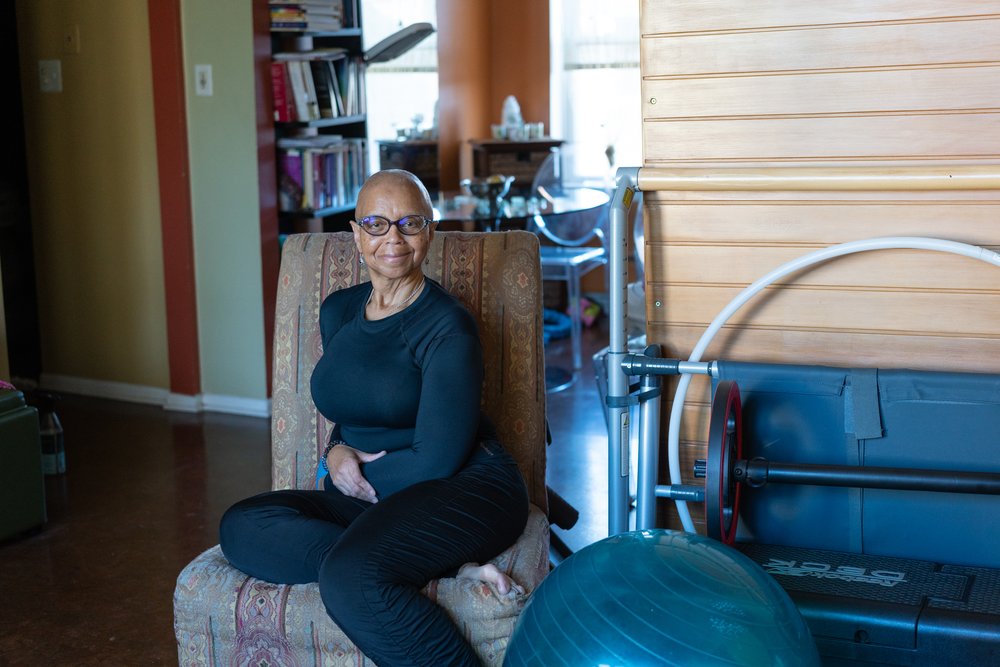
While the City has launched pilot programs to support existing co-ops and help fund new ones, Hodges said co-ops need more long-term investment. She’s also skeptical of the City’s new initiatives, which are expected to provide funding to organizations that support limited- equity co-ops and eventually to the creation of limited-equity co-ops.
The City’s South Shore Condo/Co-op Preservation Fund Pilot is a $15 million program slated to support existing condos and co-ops in South Shore with needed maintenance repairs. The Community Wealth Ecosystem Building (Community WEB) Program is another $15 million pilot that intends to help limited-equity housing co-ops on the South and West sides by providing outreach, education, legal and governance support to securing assets and property.
But Hodges takes issue with the fact that co-op members need to front the money themselves and wait for City reimbursement, rather than receiving funds that they can spend. “They dangle carrots,” Hodges said. “If you have the grant monies [and] the paperwork, and we have whatever we need to show… why should we have to be reimbursed? We don’t have money in the first place.”
Nneka Onwuzurike, who leads the wealth building initiative, said she hears the criticism and is thinking of ways to help with cash flow. Technically, she said, those accepted into the program are City contractors, which is why they are not being paid up front but rather through reimbursements.
“I know a lot of people have had frustrations with [the reimbursement method] and understand the need for that to change,” Onwuzurike said.
Onwuzurike said the City’s renewed interest in investing in housing cooperatives stems from Mayor Lori Lightfoot’s desire to fix inequitable economic development. People from the mayor’s office and City departments proposed solutions to address the issue.
When Onwuzurike joined the team in June 2020, early in the COVID-19 pandemic and amid the calls for racial justice after the murder of George Floyd, she centered their strategy on the phrase “community wealth building.” “Community wealth [is] all about shared wealth,” Onwuzurike said. “So not just the sum of wealth of multiple households in the community, but how are multiple of those households coming together to co-own an asset?”
Onwuzurike said the initiative focuses specifically on limited-equity housing cooperatives because not only do they benefit residents financially by keeping living costs permanently affordable, but they also generate neighborhood stability, political power and act as an anti-gentrification tool.
For the predominantly Black and Latinx communities on the South and West Sides, “the folks that actually live there don’t own the neighborhood,” Onwuzurike said. “They don’t own the commercial real estate. They don’t own the land, the businesses, [most] of the housing there.”
Onwuzurike recognizes that some residents may be skeptical about the pilot program and question the City’s role in supporting shared ownership. She said the program centers and listens to community voices, and intends to provide a range of resources to residents, from education to financial assistance.
“For low-income, low-wealth folks—many of whom might feel like their future is being a renter for life, but have aspirations of wanting to own a home and build assets [and] wealth—I think this is just a viable option. But it’s not well known,” Onwuzurike said. “And then for those who it is well known for, it’s then not well supported by the City.”
Uplifting co-ops as a critical option
Pilsen Housing Cooperative (PIHCO) is a limited-equity cooperative that helps keep rent low and longtime Latinx residents in the neighborhood. The cooperative’s mantra is “quédate en Pilsen,” or “stay in Pilsen.”
Iván Arenas, a PIHCO member, organizer, and associate director of the Institute for Research on Race and Public Policy at the University of Illinois Chicago, said there are many challenges to starting a housing cooperative, especially limited-equity ones. He said that the kinds of properties that developers are looking for are often the same kind of properties that a limited-equity housing hub would be interested in.
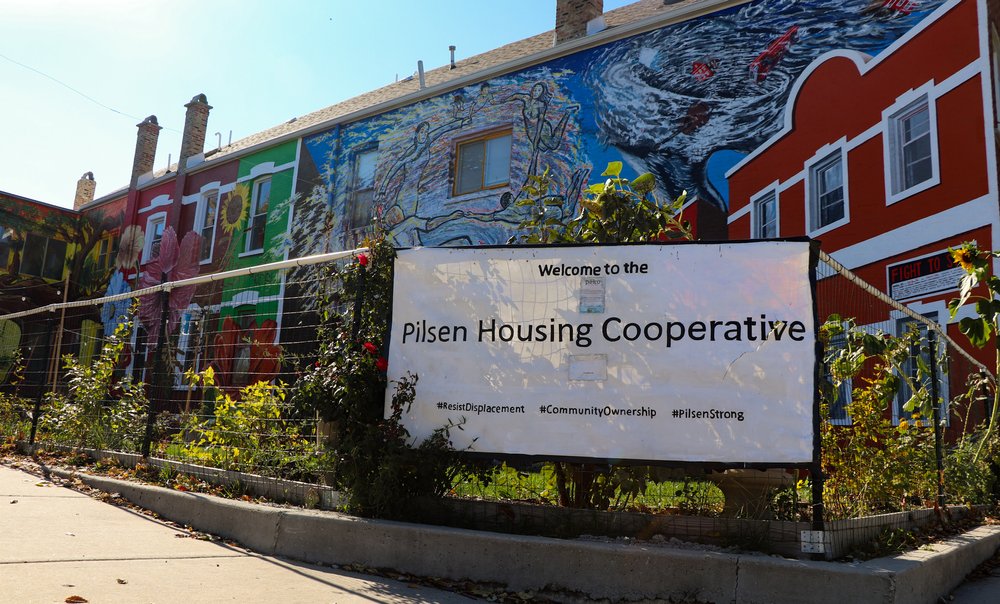
“The way we purchase housing is really in kind of direct competition with not only other folks who have more resources,” Arenas said, “but, more importantly, developers who don’t even have to think about, for example, what interest rates are for loans and so on because they have the kind of cash on hand to be able to quickly purchase a property that they feel is valuable.”
For PIHCO’s first and biggest property, the owner chose to sell directly to the co-op and then join it himself. That meant PIHCO didn’t need to get a loan from a bank or credit union. Instead, they got a loan from the building seller who joined the co-op.
Arenas said that while the City has many programs in place to support different types of housing, cooperatives are often excluded because of a lack of awareness.
“[These policies] weren’t designed to be punitive against co-ops,” he said. “They just weren’t designed with the thought of co-ops in mind.”
The University of Chicago Housing Initiative Transactional Clinic offers pro bono legal advice and support to people interested in developing affordable housing, including co-ops. The clinic’s lawyers help with a number of legal steps—crafting bylaws, acquiring property, finding funding—that make the co-op process intimidating. They also advise on pricing and monthly rates to ensure that the co-op is able to function while remaining affordable.
The clinic is a vital resource for current and potential co-op members and, like many resources available for co-ops, those who may be interested tend to find out about the services through word of mouth.
Jeff Leslie, the clinic’s director, said that to implement co-ops as a mainstream housing option, advocates should not reinvent the wheel. Instead, they should advocate to add co-ops to established programs, like the Chicago Housing Authority’s Choose to Own Homeownership Program, which provides qualified public housing and Housing Choice Voucher residents with subsidies to buy a home, as well as monthly mortgage assistance.
“If those agencies did include co-ops in those programs, people who are thinking about transitioning from renting to homeownership would learn about co-ops,” Leslie said.
Laura Garcia, an organizer at the Metropolitan Tenants Organization, which is made up of tenants, tenant organizations, and community members working to increase access to and maintain affordable housing in Chicago, said that the lack of investment and education of affordable housing options is a part of a bigger culture that fails to value and prioritize the rights of renters.
“We tend to classify renters as less than those that have been able to afford or purchase a home and become a landlord,” Garcia said. “Somehow [they] have more rights and are entitled to more than renters, which … shouldn’t be the case.”
Both Garcia and the tenants who work alongside her want something that they can call their own, and strongly believe that those who desire to own a home should have all options made available to them. “We celebrate that ‘bootstrap mentality,’ but we fail to take into account that there’s a lot of things working against these very communities,” she said. “Tenants want something stable.”
Making it last
Since there isn’t one hub of information for those looking to create a co-op in Chicago, people have relied on established co-ops to show them the ropes. But co-op advocates say the City should do more and point to New York City as an example.
The Urban Homesteading Assistance Board (UHAB) was created in New York City in 1973 to combat the worsening conditions of neighborhoods that had been subjected to redlining. Today, UHAB works toward “democratic community control” of housing through the creation and sustaining of housing co-ops, granting first-time homebuyer loans and strengthening tenants unions. The organization is supported by the New York City Department of Housing Preservation and Development and the New York City Council as well as banks and land trusts.
Chicago can help by actively supporting local organizations similar to UHAB and by establishing a streamlined process for creating or joining a co-op, according to co-op residents and advocates. In the meantime, organizations like the Center for Shared Ownership and Chicago Co-op Convergence, and co-op members are filling that role.
Rev. Bernadine Harvin has been a member of the limited-equity Chatham Park Village Cooperative for four years. She said the collectivist culture of cooperatives has been harnessed by Black communities for generations, as both a means of survival and care.
“If you’re looking at just collective economy, collective resourcing, collective surviving, that’s why we’re here,” she said. “Because our ancestors survived.”
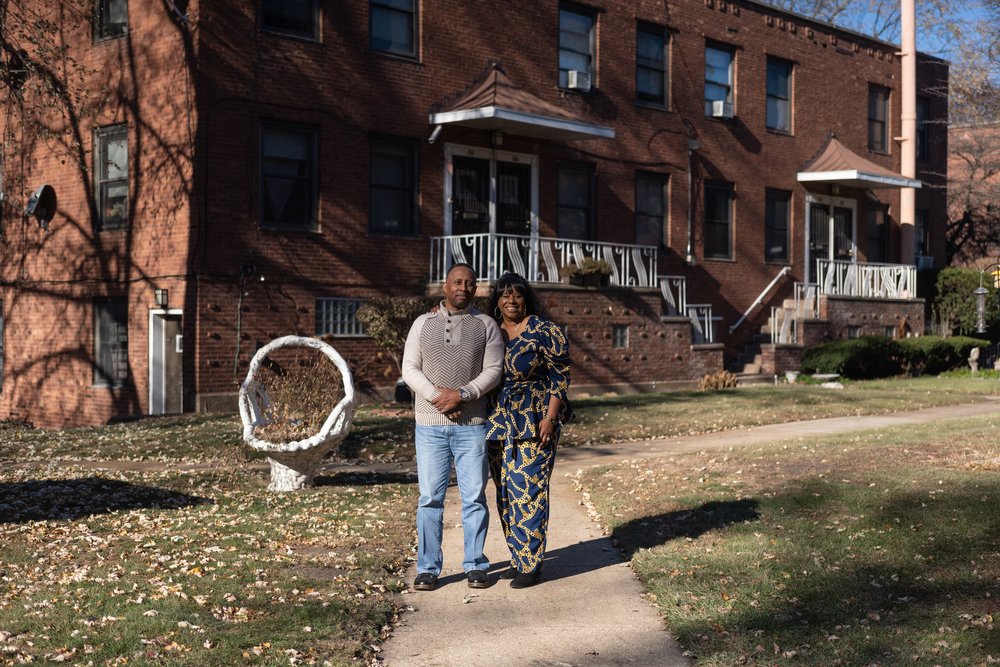
Four generations of Marion Turner’s family live in Woolman-Washington. It’s not the only multi-generational family to call the co-op home. Her granddaughter Kimberly Turner, as board president, attends networking events and connects with all types of co-ops around the city to see how they operate. Throughout her time living at Woolman-Washington, she’s witnessed organizers in the co-op space become increasingly connected.
“We are focused on keeping cooperatives [affordable] for people,” Kimberly Turner said. “That’s the difference from apartment buildings. We have the opportunity to keep things a little bit more reasonable than what apartment buildings may do.”
Marion Turner thinks things are running smoothly. After recently visiting an open house for a home next door, she was shocked to learn how much rent in Wicker Park is today. She hopes Woolman-Washington survives.
“I hope it lasts, I hope it continues to last,” she said. “I hope it don’t fade away.”
Grace Del Vecchio and Sonal Soni are 2022 Fall Civic Reporting Fellows. Jerrel Floyd, City Bureau’s engagement reporter covering economic development and segregation in Chicago, contributed to this report.



